Case Study: Recognising and Responding to Acutely Ill Patient
VerifiedAdded on 2023/06/11
|15
|5432
|265
Case Study
AI Summary
This case study focuses on the assessment and management of Michael Green, a 62-year-old male patient experiencing chest pain and related symptoms indicative of a potential myocardial infarction. The report details the initial nursing assessment using the A-E approach (Airway, Breathing, Circulation, Disability, Exposure) and NEWS2 scoring to evaluate the patient's condition. It explores the pathophysiology behind Michael's symptoms, including the role of atherosclerosis and the body's inflammatory response. The nursing and medical management strategies are discussed, emphasizing the importance of patient-centered and holistic care to address both the physical and psychosocial aspects of Michael's recovery. The case study also highlights the significance of effective communication using tools like SBAR to ensure seamless patient handover and coordinated care.
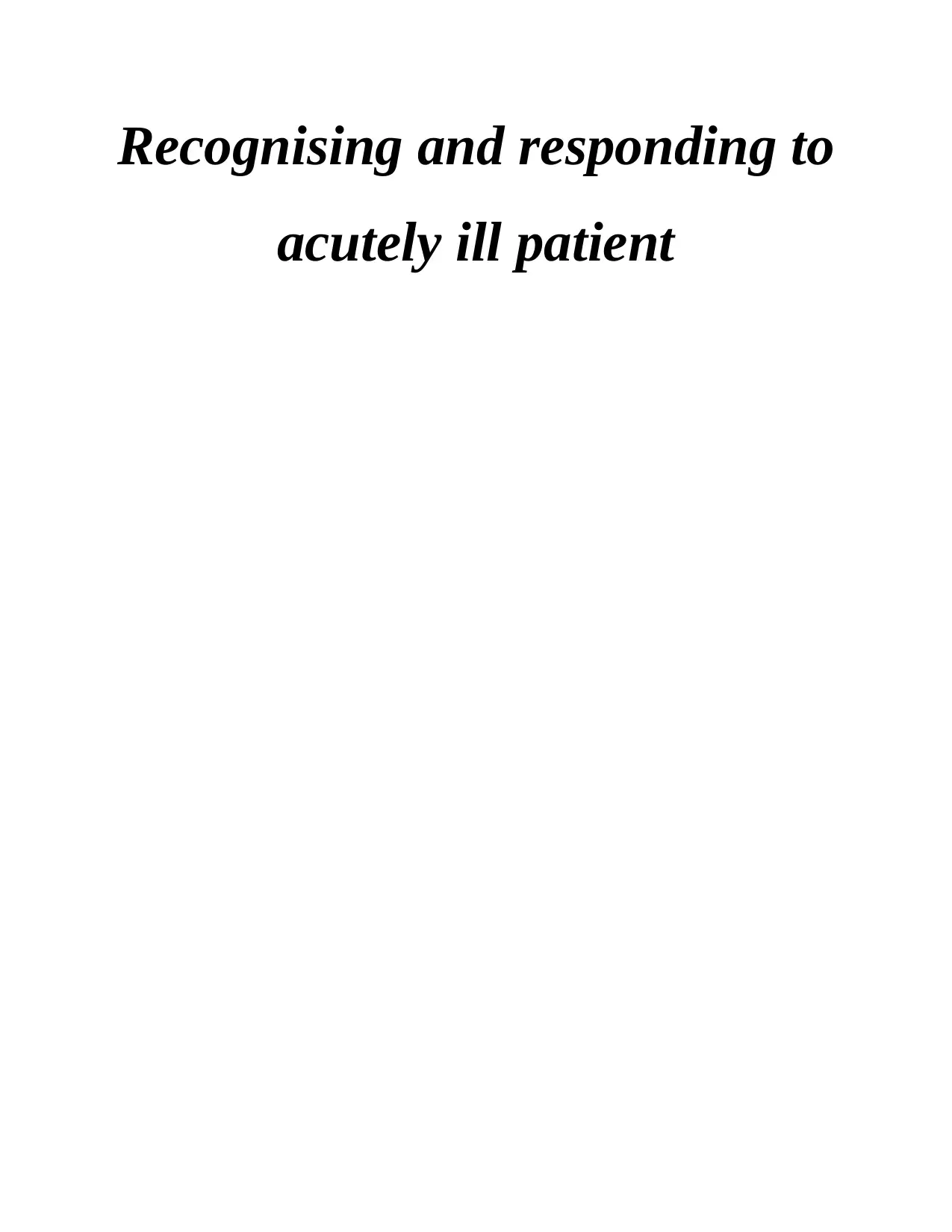
Recognising and responding to
acutely ill patient
acutely ill patient
Secure Best Marks with AI Grader
Need help grading? Try our AI Grader for instant feedback on your assignments.
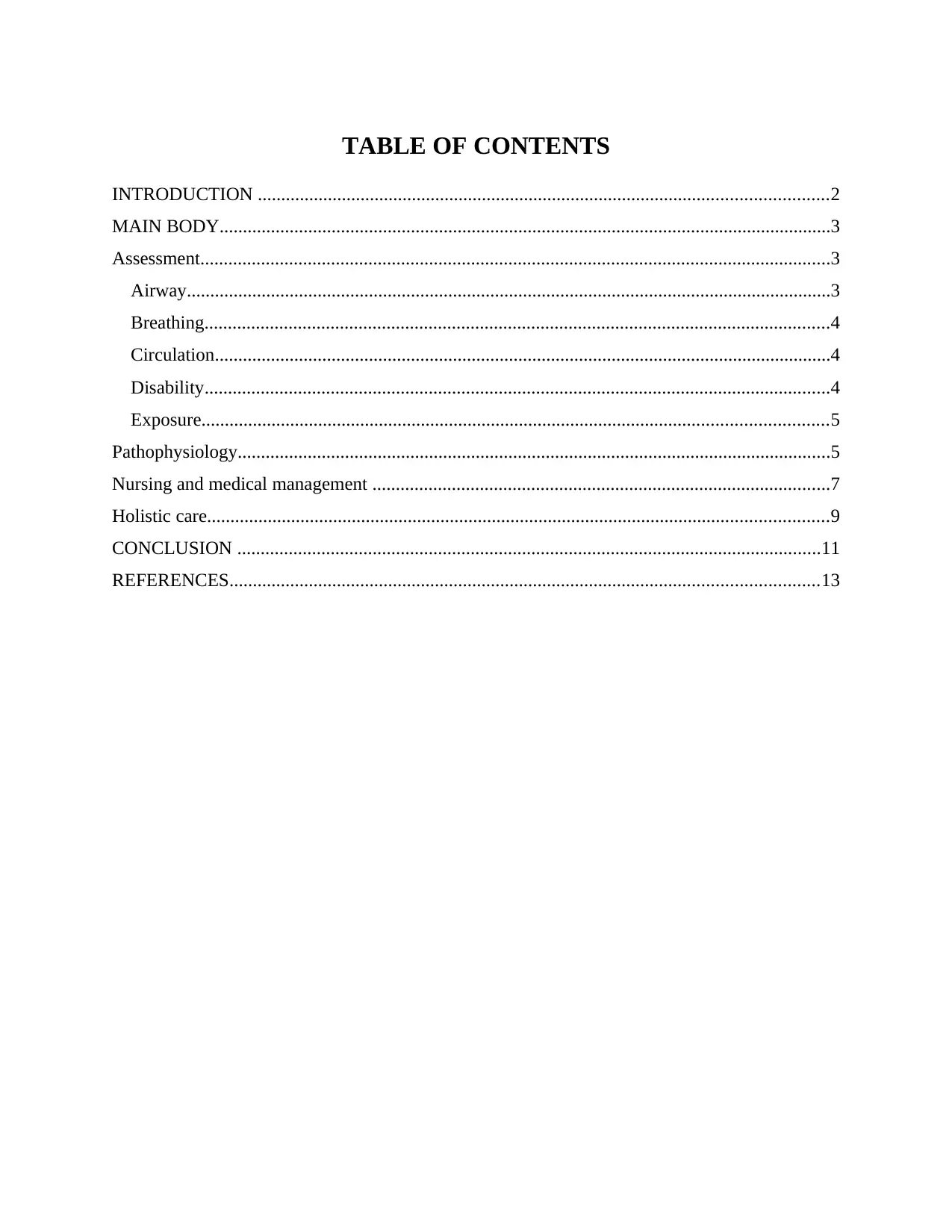
TABLE OF CONTENTS
INTRODUCTION ..........................................................................................................................2
MAIN BODY...................................................................................................................................3
Assessment.......................................................................................................................................3
Airway..........................................................................................................................................3
Breathing......................................................................................................................................4
Circulation....................................................................................................................................4
Disability......................................................................................................................................4
Exposure......................................................................................................................................5
Pathophysiology...............................................................................................................................5
Nursing and medical management ..................................................................................................7
Holistic care.....................................................................................................................................9
CONCLUSION .............................................................................................................................11
REFERENCES..............................................................................................................................13
INTRODUCTION ..........................................................................................................................2
MAIN BODY...................................................................................................................................3
Assessment.......................................................................................................................................3
Airway..........................................................................................................................................3
Breathing......................................................................................................................................4
Circulation....................................................................................................................................4
Disability......................................................................................................................................4
Exposure......................................................................................................................................5
Pathophysiology...............................................................................................................................5
Nursing and medical management ..................................................................................................7
Holistic care.....................................................................................................................................9
CONCLUSION .............................................................................................................................11
REFERENCES..............................................................................................................................13
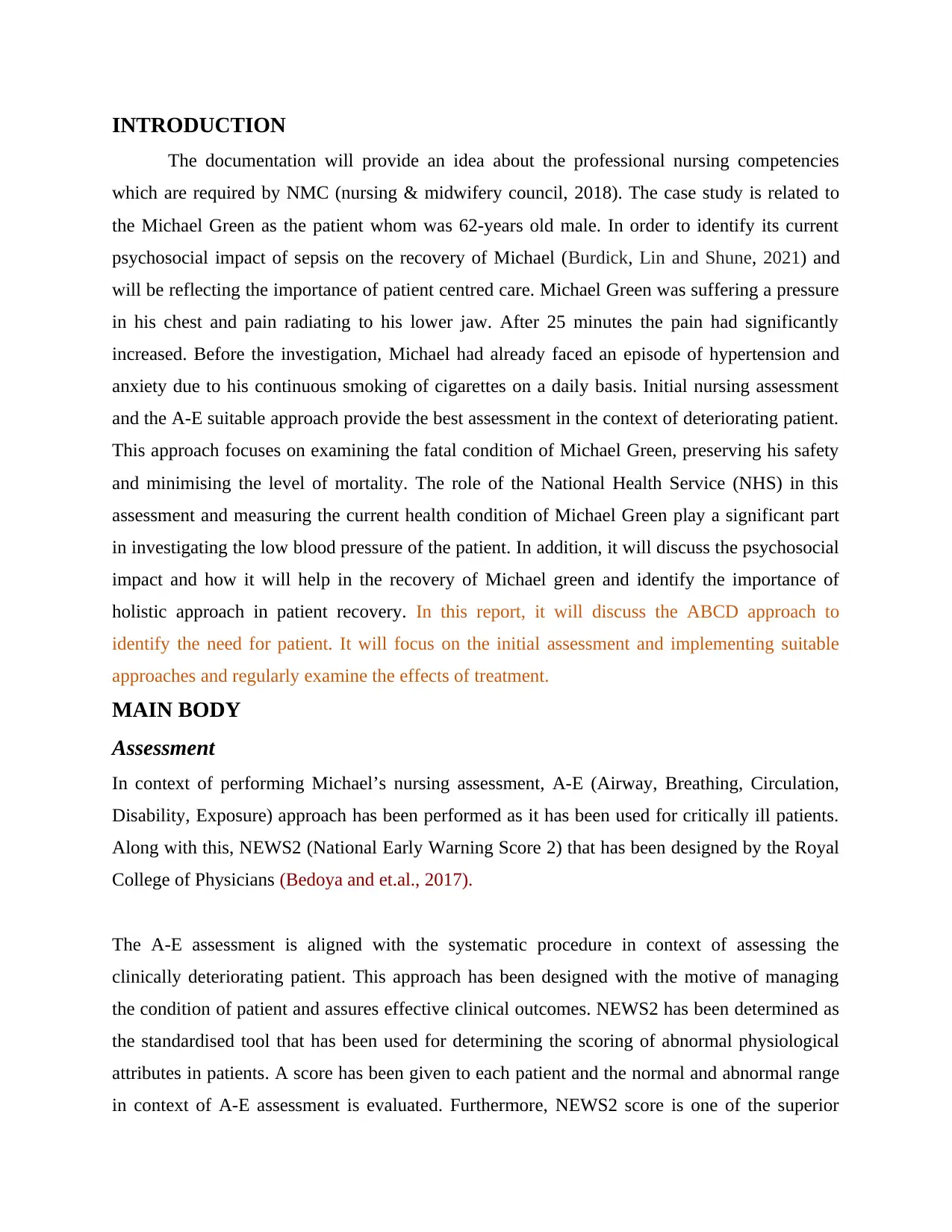
INTRODUCTION
The documentation will provide an idea about the professional nursing competencies
which are required by NMC (nursing & midwifery council, 2018). The case study is related to
the Michael Green as the patient whom was 62-years old male. In order to identify its current
psychosocial impact of sepsis on the recovery of Michael (Burdick, Lin and Shune, 2021) and
will be reflecting the importance of patient centred care. Michael Green was suffering a pressure
in his chest and pain radiating to his lower jaw. After 25 minutes the pain had significantly
increased. Before the investigation, Michael had already faced an episode of hypertension and
anxiety due to his continuous smoking of cigarettes on a daily basis. Initial nursing assessment
and the A-E suitable approach provide the best assessment in the context of deteriorating patient.
This approach focuses on examining the fatal condition of Michael Green, preserving his safety
and minimising the level of mortality. The role of the National Health Service (NHS) in this
assessment and measuring the current health condition of Michael Green play a significant part
in investigating the low blood pressure of the patient. In addition, it will discuss the psychosocial
impact and how it will help in the recovery of Michael green and identify the importance of
holistic approach in patient recovery. In this report, it will discuss the ABCD approach to
identify the need for patient. It will focus on the initial assessment and implementing suitable
approaches and regularly examine the effects of treatment.
MAIN BODY
Assessment
In context of performing Michael’s nursing assessment, A-E (Airway, Breathing, Circulation,
Disability, Exposure) approach has been performed as it has been used for critically ill patients.
Along with this, NEWS2 (National Early Warning Score 2) that has been designed by the Royal
College of Physicians (Bedoya and et.al., 2017).
The A-E assessment is aligned with the systematic procedure in context of assessing the
clinically deteriorating patient. This approach has been designed with the motive of managing
the condition of patient and assures effective clinical outcomes. NEWS2 has been determined as
the standardised tool that has been used for determining the scoring of abnormal physiological
attributes in patients. A score has been given to each patient and the normal and abnormal range
in context of A-E assessment is evaluated. Furthermore, NEWS2 score is one of the superior
The documentation will provide an idea about the professional nursing competencies
which are required by NMC (nursing & midwifery council, 2018). The case study is related to
the Michael Green as the patient whom was 62-years old male. In order to identify its current
psychosocial impact of sepsis on the recovery of Michael (Burdick, Lin and Shune, 2021) and
will be reflecting the importance of patient centred care. Michael Green was suffering a pressure
in his chest and pain radiating to his lower jaw. After 25 minutes the pain had significantly
increased. Before the investigation, Michael had already faced an episode of hypertension and
anxiety due to his continuous smoking of cigarettes on a daily basis. Initial nursing assessment
and the A-E suitable approach provide the best assessment in the context of deteriorating patient.
This approach focuses on examining the fatal condition of Michael Green, preserving his safety
and minimising the level of mortality. The role of the National Health Service (NHS) in this
assessment and measuring the current health condition of Michael Green play a significant part
in investigating the low blood pressure of the patient. In addition, it will discuss the psychosocial
impact and how it will help in the recovery of Michael green and identify the importance of
holistic approach in patient recovery. In this report, it will discuss the ABCD approach to
identify the need for patient. It will focus on the initial assessment and implementing suitable
approaches and regularly examine the effects of treatment.
MAIN BODY
Assessment
In context of performing Michael’s nursing assessment, A-E (Airway, Breathing, Circulation,
Disability, Exposure) approach has been performed as it has been used for critically ill patients.
Along with this, NEWS2 (National Early Warning Score 2) that has been designed by the Royal
College of Physicians (Bedoya and et.al., 2017).
The A-E assessment is aligned with the systematic procedure in context of assessing the
clinically deteriorating patient. This approach has been designed with the motive of managing
the condition of patient and assures effective clinical outcomes. NEWS2 has been determined as
the standardised tool that has been used for determining the scoring of abnormal physiological
attributes in patients. A score has been given to each patient and the normal and abnormal range
in context of A-E assessment is evaluated. Furthermore, NEWS2 score is one of the superior
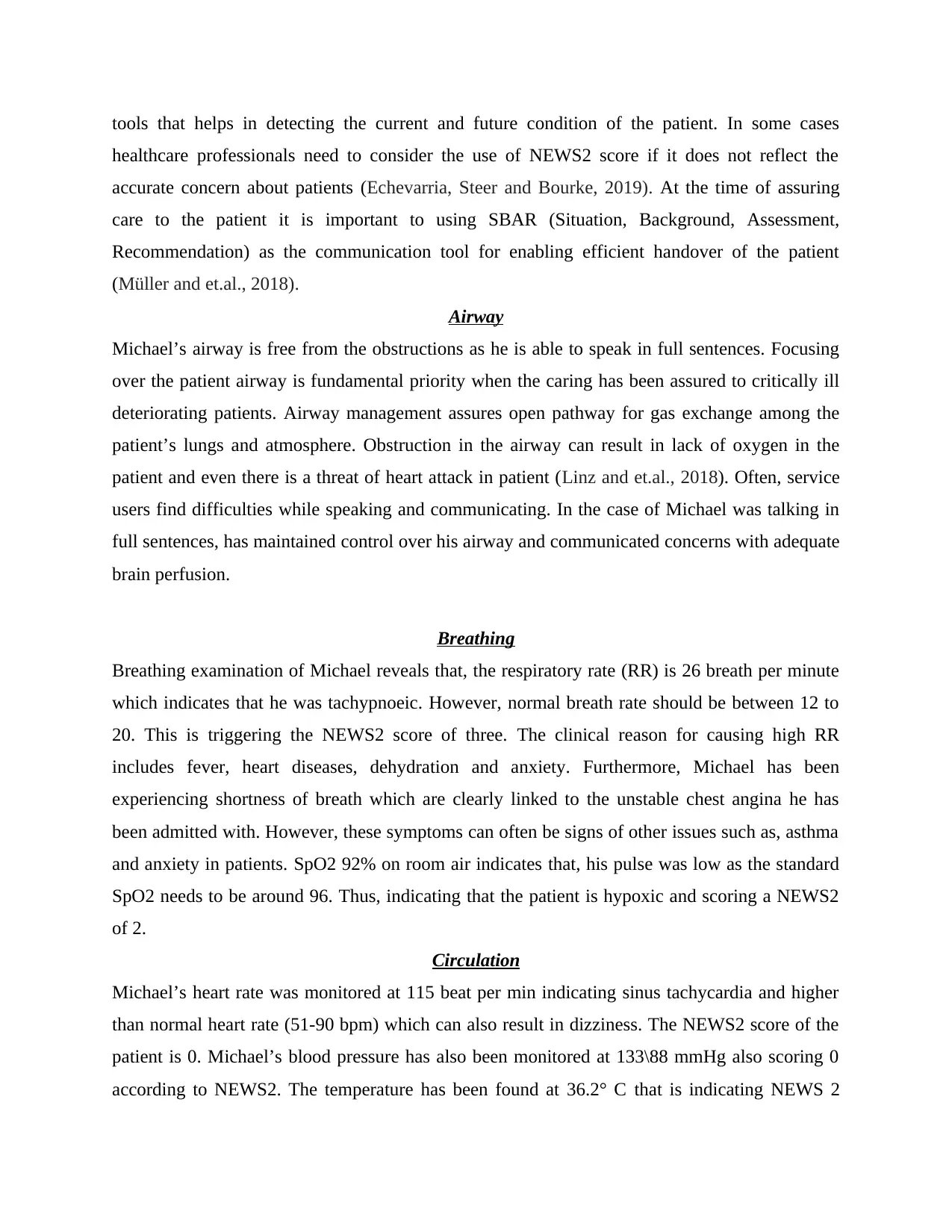
tools that helps in detecting the current and future condition of the patient. In some cases
healthcare professionals need to consider the use of NEWS2 score if it does not reflect the
accurate concern about patients (Echevarria, Steer and Bourke, 2019). At the time of assuring
care to the patient it is important to using SBAR (Situation, Background, Assessment,
Recommendation) as the communication tool for enabling efficient handover of the patient
(Müller and et.al., 2018).
Airway
Michael’s airway is free from the obstructions as he is able to speak in full sentences. Focusing
over the patient airway is fundamental priority when the caring has been assured to critically ill
deteriorating patients. Airway management assures open pathway for gas exchange among the
patient’s lungs and atmosphere. Obstruction in the airway can result in lack of oxygen in the
patient and even there is a threat of heart attack in patient (Linz and et.al., 2018). Often, service
users find difficulties while speaking and communicating. In the case of Michael was talking in
full sentences, has maintained control over his airway and communicated concerns with adequate
brain perfusion.
Breathing
Breathing examination of Michael reveals that, the respiratory rate (RR) is 26 breath per minute
which indicates that he was tachypnoeic. However, normal breath rate should be between 12 to
20. This is triggering the NEWS2 score of three. The clinical reason for causing high RR
includes fever, heart diseases, dehydration and anxiety. Furthermore, Michael has been
experiencing shortness of breath which are clearly linked to the unstable chest angina he has
been admitted with. However, these symptoms can often be signs of other issues such as, asthma
and anxiety in patients. SpO2 92% on room air indicates that, his pulse was low as the standard
SpO2 needs to be around 96. Thus, indicating that the patient is hypoxic and scoring a NEWS2
of 2.
Circulation
Michael’s heart rate was monitored at 115 beat per min indicating sinus tachycardia and higher
than normal heart rate (51-90 bpm) which can also result in dizziness. The NEWS2 score of the
patient is 0. Michael’s blood pressure has also been monitored at 133\88 mmHg also scoring 0
according to NEWS2. The temperature has been found at 36.2° C that is indicating NEWS 2
healthcare professionals need to consider the use of NEWS2 score if it does not reflect the
accurate concern about patients (Echevarria, Steer and Bourke, 2019). At the time of assuring
care to the patient it is important to using SBAR (Situation, Background, Assessment,
Recommendation) as the communication tool for enabling efficient handover of the patient
(Müller and et.al., 2018).
Airway
Michael’s airway is free from the obstructions as he is able to speak in full sentences. Focusing
over the patient airway is fundamental priority when the caring has been assured to critically ill
deteriorating patients. Airway management assures open pathway for gas exchange among the
patient’s lungs and atmosphere. Obstruction in the airway can result in lack of oxygen in the
patient and even there is a threat of heart attack in patient (Linz and et.al., 2018). Often, service
users find difficulties while speaking and communicating. In the case of Michael was talking in
full sentences, has maintained control over his airway and communicated concerns with adequate
brain perfusion.
Breathing
Breathing examination of Michael reveals that, the respiratory rate (RR) is 26 breath per minute
which indicates that he was tachypnoeic. However, normal breath rate should be between 12 to
20. This is triggering the NEWS2 score of three. The clinical reason for causing high RR
includes fever, heart diseases, dehydration and anxiety. Furthermore, Michael has been
experiencing shortness of breath which are clearly linked to the unstable chest angina he has
been admitted with. However, these symptoms can often be signs of other issues such as, asthma
and anxiety in patients. SpO2 92% on room air indicates that, his pulse was low as the standard
SpO2 needs to be around 96. Thus, indicating that the patient is hypoxic and scoring a NEWS2
of 2.
Circulation
Michael’s heart rate was monitored at 115 beat per min indicating sinus tachycardia and higher
than normal heart rate (51-90 bpm) which can also result in dizziness. The NEWS2 score of the
patient is 0. Michael’s blood pressure has also been monitored at 133\88 mmHg also scoring 0
according to NEWS2. The temperature has been found at 36.2° C that is indicating NEWS 2
Secure Best Marks with AI Grader
Need help grading? Try our AI Grader for instant feedback on your assignments.
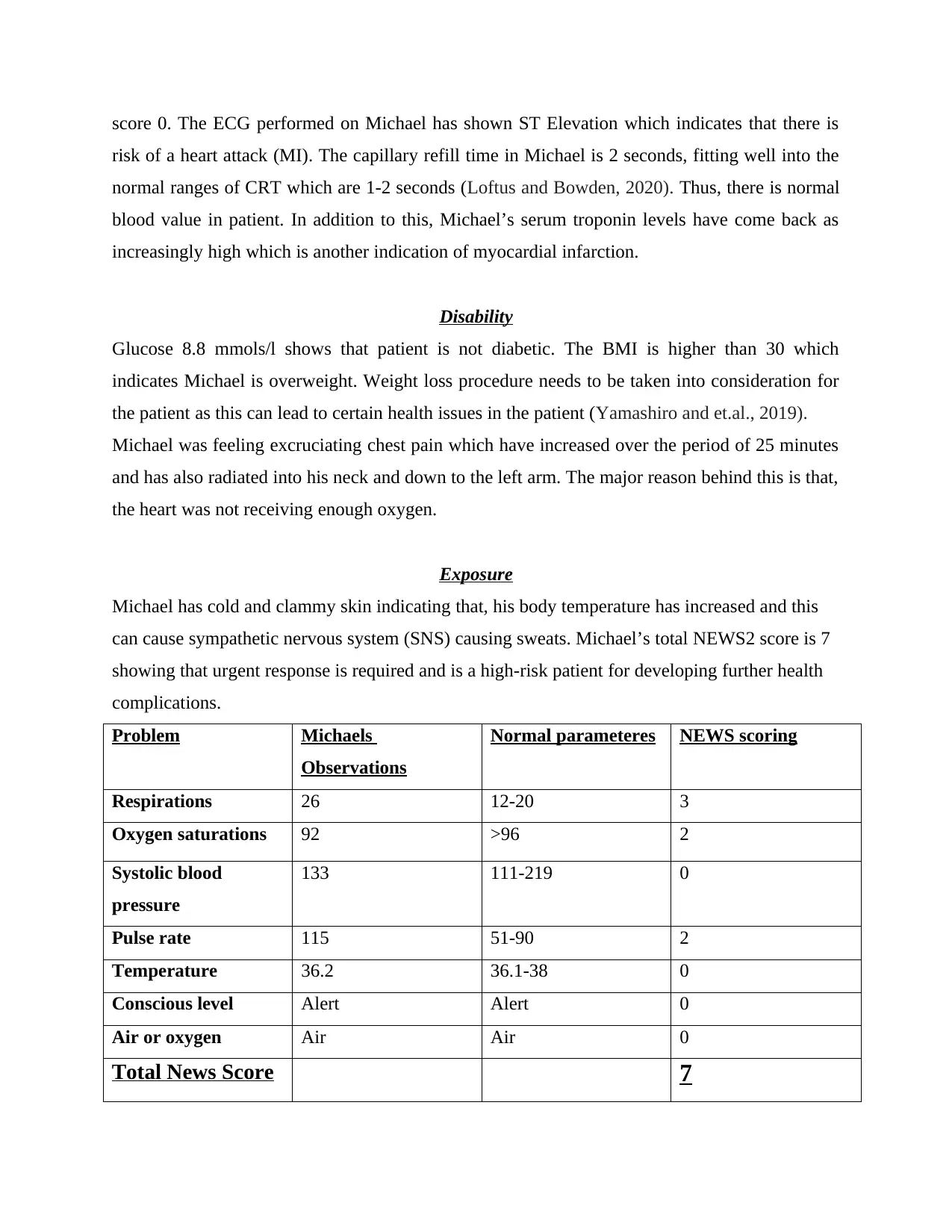
score 0. The ECG performed on Michael has shown ST Elevation which indicates that there is
risk of a heart attack (MI). The capillary refill time in Michael is 2 seconds, fitting well into the
normal ranges of CRT which are 1-2 seconds (Loftus and Bowden, 2020). Thus, there is normal
blood value in patient. In addition to this, Michael’s serum troponin levels have come back as
increasingly high which is another indication of myocardial infarction.
Disability
Glucose 8.8 mmols/l shows that patient is not diabetic. The BMI is higher than 30 which
indicates Michael is overweight. Weight loss procedure needs to be taken into consideration for
the patient as this can lead to certain health issues in the patient (Yamashiro and et.al., 2019).
Michael was feeling excruciating chest pain which have increased over the period of 25 minutes
and has also radiated into his neck and down to the left arm. The major reason behind this is that,
the heart was not receiving enough oxygen.
Exposure
Michael has cold and clammy skin indicating that, his body temperature has increased and this
can cause sympathetic nervous system (SNS) causing sweats. Michael’s total NEWS2 score is 7
showing that urgent response is required and is a high-risk patient for developing further health
complications.
Problem Michaels
Observations
Normal parameteres NEWS scoring
Respirations 26 12-20 3
Oxygen saturations 92 >96 2
Systolic blood
pressure
133 111-219 0
Pulse rate 115 51-90 2
Temperature 36.2 36.1-38 0
Conscious level Alert Alert 0
Air or oxygen Air Air 0
Total News Score 7
risk of a heart attack (MI). The capillary refill time in Michael is 2 seconds, fitting well into the
normal ranges of CRT which are 1-2 seconds (Loftus and Bowden, 2020). Thus, there is normal
blood value in patient. In addition to this, Michael’s serum troponin levels have come back as
increasingly high which is another indication of myocardial infarction.
Disability
Glucose 8.8 mmols/l shows that patient is not diabetic. The BMI is higher than 30 which
indicates Michael is overweight. Weight loss procedure needs to be taken into consideration for
the patient as this can lead to certain health issues in the patient (Yamashiro and et.al., 2019).
Michael was feeling excruciating chest pain which have increased over the period of 25 minutes
and has also radiated into his neck and down to the left arm. The major reason behind this is that,
the heart was not receiving enough oxygen.
Exposure
Michael has cold and clammy skin indicating that, his body temperature has increased and this
can cause sympathetic nervous system (SNS) causing sweats. Michael’s total NEWS2 score is 7
showing that urgent response is required and is a high-risk patient for developing further health
complications.
Problem Michaels
Observations
Normal parameteres NEWS scoring
Respirations 26 12-20 3
Oxygen saturations 92 >96 2
Systolic blood
pressure
133 111-219 0
Pulse rate 115 51-90 2
Temperature 36.2 36.1-38 0
Conscious level Alert Alert 0
Air or oxygen Air Air 0
Total News Score 7
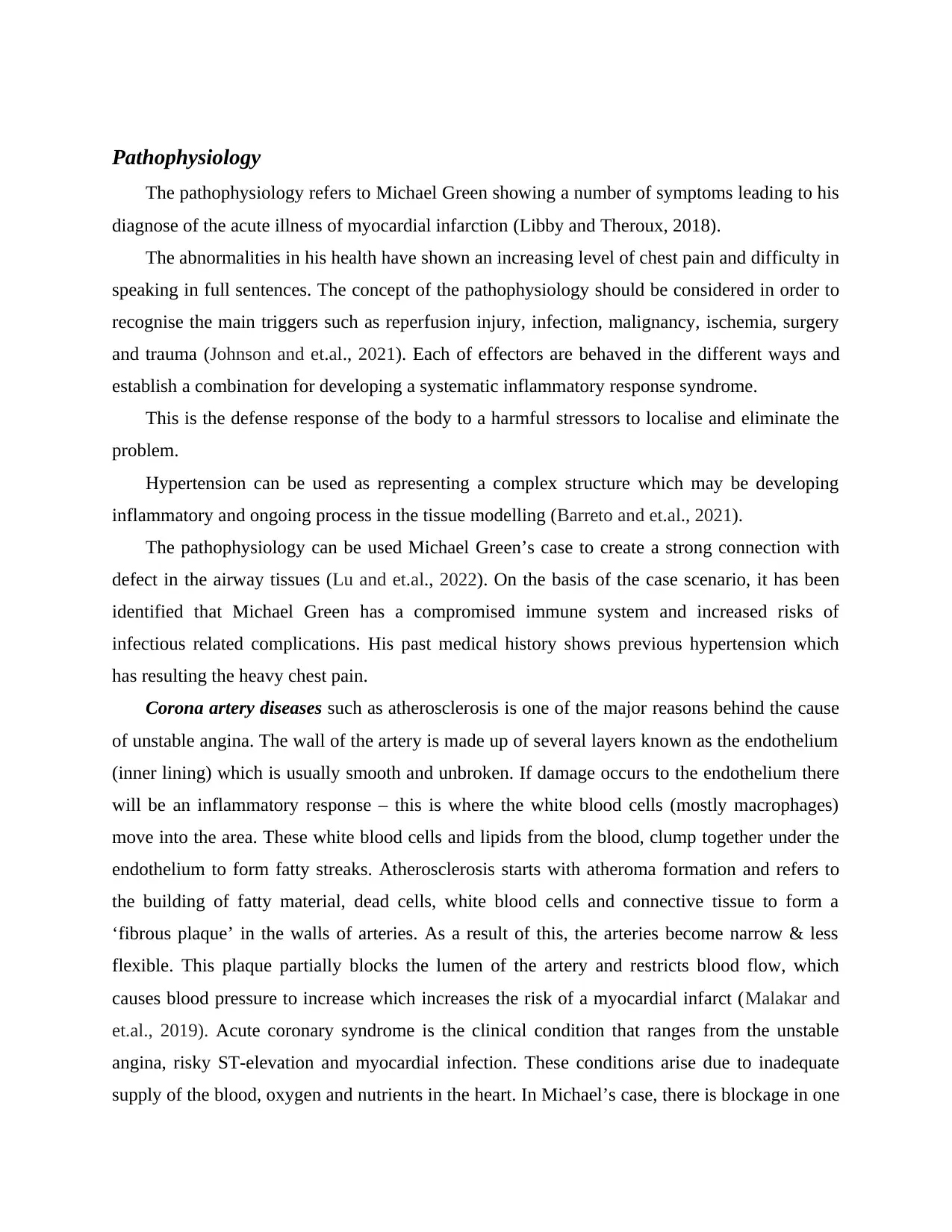
Pathophysiology
The pathophysiology refers to Michael Green showing a number of symptoms leading to his
diagnose of the acute illness of myocardial infarction (Libby and Theroux, 2018).
The abnormalities in his health have shown an increasing level of chest pain and difficulty in
speaking in full sentences. The concept of the pathophysiology should be considered in order to
recognise the main triggers such as reperfusion injury, infection, malignancy, ischemia, surgery
and trauma (Johnson and et.al., 2021). Each of effectors are behaved in the different ways and
establish a combination for developing a systematic inflammatory response syndrome.
This is the defense response of the body to a harmful stressors to localise and eliminate the
problem.
Hypertension can be used as representing a complex structure which may be developing
inflammatory and ongoing process in the tissue modelling (Barreto and et.al., 2021).
The pathophysiology can be used Michael Green’s case to create a strong connection with
defect in the airway tissues (Lu and et.al., 2022). On the basis of the case scenario, it has been
identified that Michael Green has a compromised immune system and increased risks of
infectious related complications. His past medical history shows previous hypertension which
has resulting the heavy chest pain.
Corona artery diseases such as atherosclerosis is one of the major reasons behind the cause
of unstable angina. The wall of the artery is made up of several layers known as the endothelium
(inner lining) which is usually smooth and unbroken. If damage occurs to the endothelium there
will be an inflammatory response – this is where the white blood cells (mostly macrophages)
move into the area. These white blood cells and lipids from the blood, clump together under the
endothelium to form fatty streaks. Atherosclerosis starts with atheroma formation and refers to
the building of fatty material, dead cells, white blood cells and connective tissue to form a
‘fibrous plaque’ in the walls of arteries. As a result of this, the arteries become narrow & less
flexible. This plaque partially blocks the lumen of the artery and restricts blood flow, which
causes blood pressure to increase which increases the risk of a myocardial infarct (Malakar and
et.al., 2019). Acute coronary syndrome is the clinical condition that ranges from the unstable
angina, risky ST-elevation and myocardial infection. These conditions arise due to inadequate
supply of the blood, oxygen and nutrients in the heart. In Michael’s case, there is blockage in one
The pathophysiology refers to Michael Green showing a number of symptoms leading to his
diagnose of the acute illness of myocardial infarction (Libby and Theroux, 2018).
The abnormalities in his health have shown an increasing level of chest pain and difficulty in
speaking in full sentences. The concept of the pathophysiology should be considered in order to
recognise the main triggers such as reperfusion injury, infection, malignancy, ischemia, surgery
and trauma (Johnson and et.al., 2021). Each of effectors are behaved in the different ways and
establish a combination for developing a systematic inflammatory response syndrome.
This is the defense response of the body to a harmful stressors to localise and eliminate the
problem.
Hypertension can be used as representing a complex structure which may be developing
inflammatory and ongoing process in the tissue modelling (Barreto and et.al., 2021).
The pathophysiology can be used Michael Green’s case to create a strong connection with
defect in the airway tissues (Lu and et.al., 2022). On the basis of the case scenario, it has been
identified that Michael Green has a compromised immune system and increased risks of
infectious related complications. His past medical history shows previous hypertension which
has resulting the heavy chest pain.
Corona artery diseases such as atherosclerosis is one of the major reasons behind the cause
of unstable angina. The wall of the artery is made up of several layers known as the endothelium
(inner lining) which is usually smooth and unbroken. If damage occurs to the endothelium there
will be an inflammatory response – this is where the white blood cells (mostly macrophages)
move into the area. These white blood cells and lipids from the blood, clump together under the
endothelium to form fatty streaks. Atherosclerosis starts with atheroma formation and refers to
the building of fatty material, dead cells, white blood cells and connective tissue to form a
‘fibrous plaque’ in the walls of arteries. As a result of this, the arteries become narrow & less
flexible. This plaque partially blocks the lumen of the artery and restricts blood flow, which
causes blood pressure to increase which increases the risk of a myocardial infarct (Malakar and
et.al., 2019). Acute coronary syndrome is the clinical condition that ranges from the unstable
angina, risky ST-elevation and myocardial infection. These conditions arise due to inadequate
supply of the blood, oxygen and nutrients in the heart. In Michael’s case, there is blockage in one
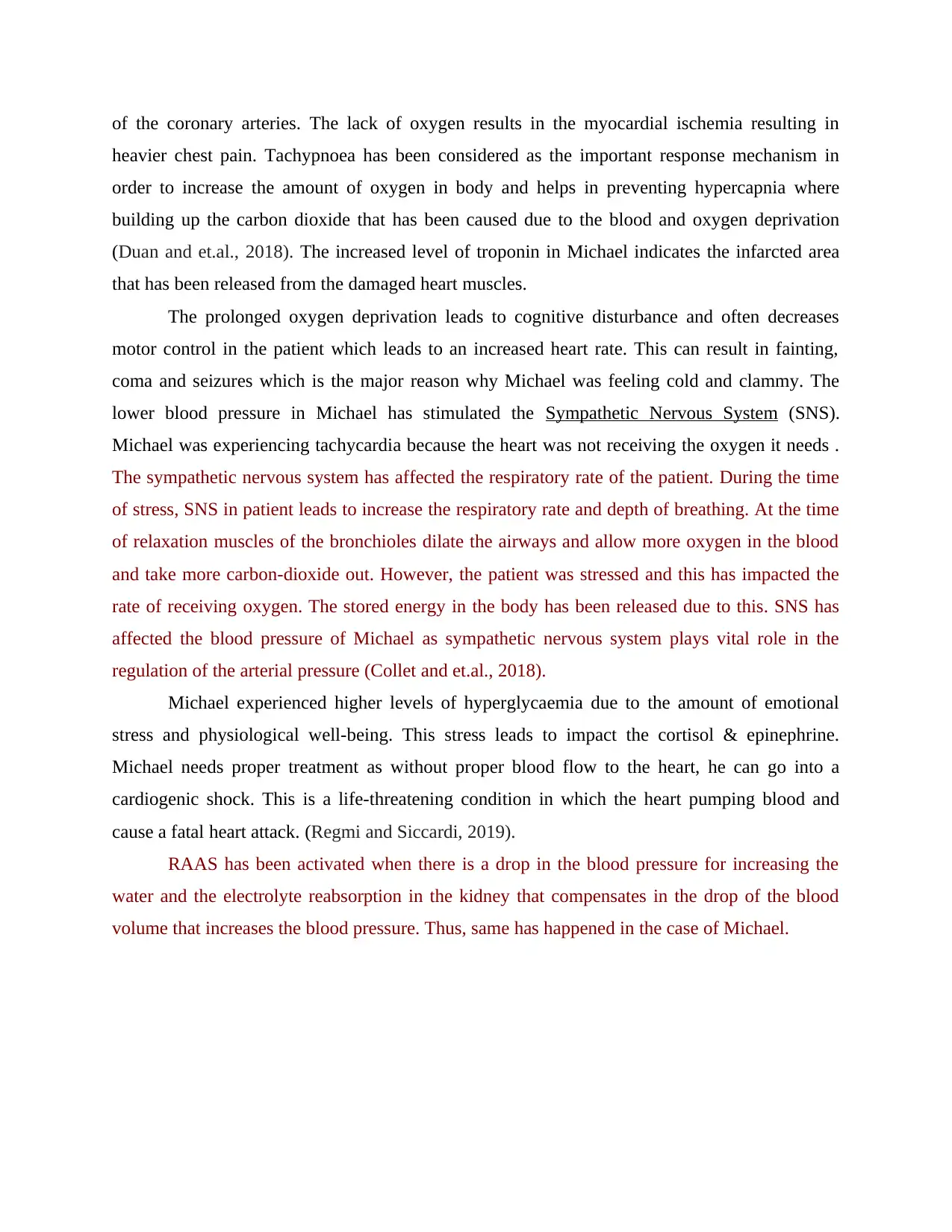
of the coronary arteries. The lack of oxygen results in the myocardial ischemia resulting in
heavier chest pain. Tachypnoea has been considered as the important response mechanism in
order to increase the amount of oxygen in body and helps in preventing hypercapnia where
building up the carbon dioxide that has been caused due to the blood and oxygen deprivation
(Duan and et.al., 2018). The increased level of troponin in Michael indicates the infarcted area
that has been released from the damaged heart muscles.
The prolonged oxygen deprivation leads to cognitive disturbance and often decreases
motor control in the patient which leads to an increased heart rate. This can result in fainting,
coma and seizures which is the major reason why Michael was feeling cold and clammy. The
lower blood pressure in Michael has stimulated the Sympathetic Nervous System (SNS).
Michael was experiencing tachycardia because the heart was not receiving the oxygen it needs .
The sympathetic nervous system has affected the respiratory rate of the patient. During the time
of stress, SNS in patient leads to increase the respiratory rate and depth of breathing. At the time
of relaxation muscles of the bronchioles dilate the airways and allow more oxygen in the blood
and take more carbon-dioxide out. However, the patient was stressed and this has impacted the
rate of receiving oxygen. The stored energy in the body has been released due to this. SNS has
affected the blood pressure of Michael as sympathetic nervous system plays vital role in the
regulation of the arterial pressure (Collet and et.al., 2018).
Michael experienced higher levels of hyperglycaemia due to the amount of emotional
stress and physiological well-being. This stress leads to impact the cortisol & epinephrine.
Michael needs proper treatment as without proper blood flow to the heart, he can go into a
cardiogenic shock. This is a life-threatening condition in which the heart pumping blood and
cause a fatal heart attack. (Regmi and Siccardi, 2019).
RAAS has been activated when there is a drop in the blood pressure for increasing the
water and the electrolyte reabsorption in the kidney that compensates in the drop of the blood
volume that increases the blood pressure. Thus, same has happened in the case of Michael.
heavier chest pain. Tachypnoea has been considered as the important response mechanism in
order to increase the amount of oxygen in body and helps in preventing hypercapnia where
building up the carbon dioxide that has been caused due to the blood and oxygen deprivation
(Duan and et.al., 2018). The increased level of troponin in Michael indicates the infarcted area
that has been released from the damaged heart muscles.
The prolonged oxygen deprivation leads to cognitive disturbance and often decreases
motor control in the patient which leads to an increased heart rate. This can result in fainting,
coma and seizures which is the major reason why Michael was feeling cold and clammy. The
lower blood pressure in Michael has stimulated the Sympathetic Nervous System (SNS).
Michael was experiencing tachycardia because the heart was not receiving the oxygen it needs .
The sympathetic nervous system has affected the respiratory rate of the patient. During the time
of stress, SNS in patient leads to increase the respiratory rate and depth of breathing. At the time
of relaxation muscles of the bronchioles dilate the airways and allow more oxygen in the blood
and take more carbon-dioxide out. However, the patient was stressed and this has impacted the
rate of receiving oxygen. The stored energy in the body has been released due to this. SNS has
affected the blood pressure of Michael as sympathetic nervous system plays vital role in the
regulation of the arterial pressure (Collet and et.al., 2018).
Michael experienced higher levels of hyperglycaemia due to the amount of emotional
stress and physiological well-being. This stress leads to impact the cortisol & epinephrine.
Michael needs proper treatment as without proper blood flow to the heart, he can go into a
cardiogenic shock. This is a life-threatening condition in which the heart pumping blood and
cause a fatal heart attack. (Regmi and Siccardi, 2019).
RAAS has been activated when there is a drop in the blood pressure for increasing the
water and the electrolyte reabsorption in the kidney that compensates in the drop of the blood
volume that increases the blood pressure. Thus, same has happened in the case of Michael.
Paraphrase This Document
Need a fresh take? Get an instant paraphrase of this document with our AI Paraphraser
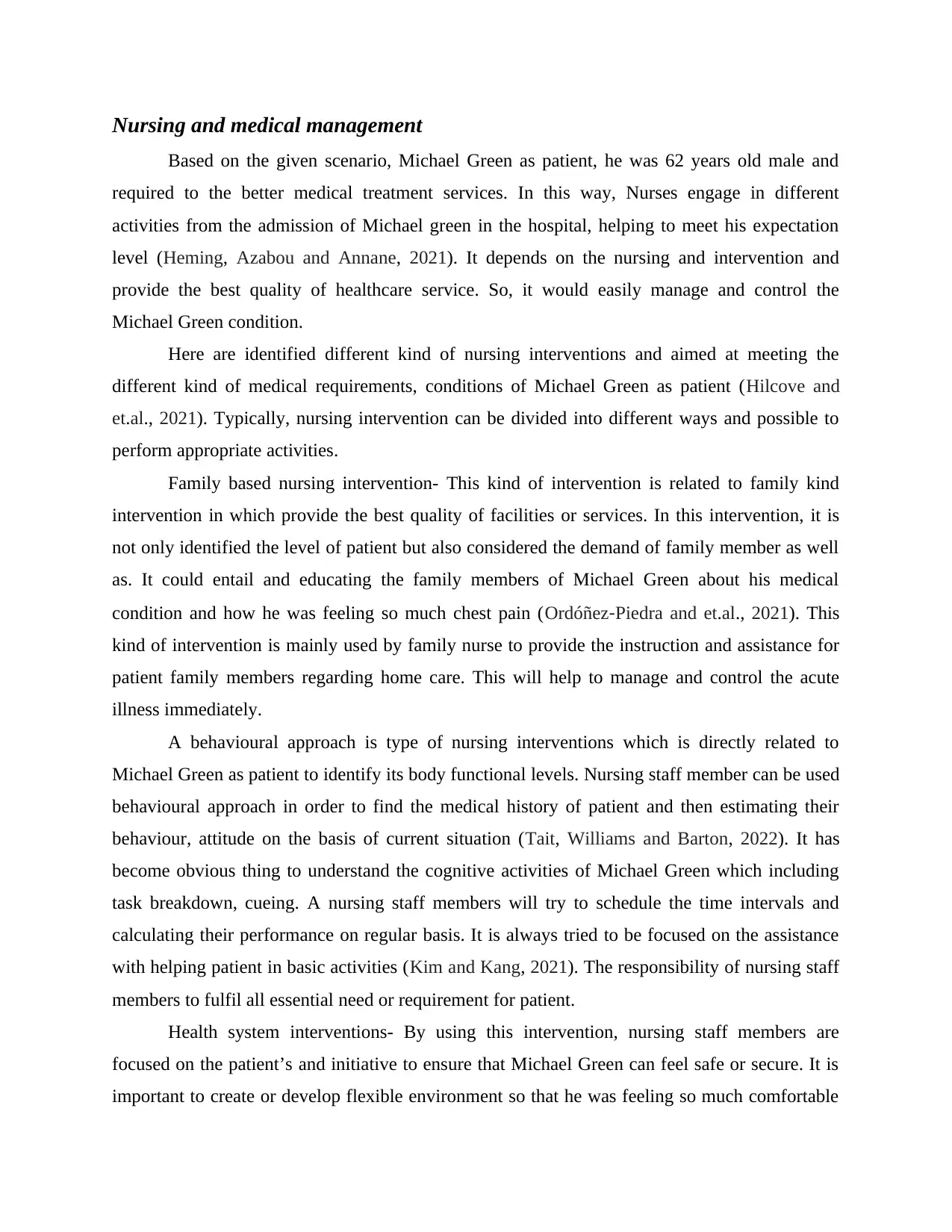
Nursing and medical management
Based on the given scenario, Michael Green as patient, he was 62 years old male and
required to the better medical treatment services. In this way, Nurses engage in different
activities from the admission of Michael green in the hospital, helping to meet his expectation
level (Heming, Azabou and Annane, 2021). It depends on the nursing and intervention and
provide the best quality of healthcare service. So, it would easily manage and control the
Michael Green condition.
Here are identified different kind of nursing interventions and aimed at meeting the
different kind of medical requirements, conditions of Michael Green as patient (Hilcove and
et.al., 2021). Typically, nursing intervention can be divided into different ways and possible to
perform appropriate activities.
Family based nursing intervention- This kind of intervention is related to family kind
intervention in which provide the best quality of facilities or services. In this intervention, it is
not only identified the level of patient but also considered the demand of family member as well
as. It could entail and educating the family members of Michael Green about his medical
condition and how he was feeling so much chest pain (Ordóñez‐Piedra and et.al., 2021). This
kind of intervention is mainly used by family nurse to provide the instruction and assistance for
patient family members regarding home care. This will help to manage and control the acute
illness immediately.
A behavioural approach is type of nursing interventions which is directly related to
Michael Green as patient to identify its body functional levels. Nursing staff member can be used
behavioural approach in order to find the medical history of patient and then estimating their
behaviour, attitude on the basis of current situation (Tait, Williams and Barton, 2022). It has
become obvious thing to understand the cognitive activities of Michael Green which including
task breakdown, cueing. A nursing staff members will try to schedule the time intervals and
calculating their performance on regular basis. It is always tried to be focused on the assistance
with helping patient in basic activities (Kim and Kang, 2021). The responsibility of nursing staff
members to fulfil all essential need or requirement for patient.
Health system interventions- By using this intervention, nursing staff members are
focused on the patient’s and initiative to ensure that Michael Green can feel safe or secure. It is
important to create or develop flexible environment so that he was feeling so much comfortable
Based on the given scenario, Michael Green as patient, he was 62 years old male and
required to the better medical treatment services. In this way, Nurses engage in different
activities from the admission of Michael green in the hospital, helping to meet his expectation
level (Heming, Azabou and Annane, 2021). It depends on the nursing and intervention and
provide the best quality of healthcare service. So, it would easily manage and control the
Michael Green condition.
Here are identified different kind of nursing interventions and aimed at meeting the
different kind of medical requirements, conditions of Michael Green as patient (Hilcove and
et.al., 2021). Typically, nursing intervention can be divided into different ways and possible to
perform appropriate activities.
Family based nursing intervention- This kind of intervention is related to family kind
intervention in which provide the best quality of facilities or services. In this intervention, it is
not only identified the level of patient but also considered the demand of family member as well
as. It could entail and educating the family members of Michael Green about his medical
condition and how he was feeling so much chest pain (Ordóñez‐Piedra and et.al., 2021). This
kind of intervention is mainly used by family nurse to provide the instruction and assistance for
patient family members regarding home care. This will help to manage and control the acute
illness immediately.
A behavioural approach is type of nursing interventions which is directly related to
Michael Green as patient to identify its body functional levels. Nursing staff member can be used
behavioural approach in order to find the medical history of patient and then estimating their
behaviour, attitude on the basis of current situation (Tait, Williams and Barton, 2022). It has
become obvious thing to understand the cognitive activities of Michael Green which including
task breakdown, cueing. A nursing staff members will try to schedule the time intervals and
calculating their performance on regular basis. It is always tried to be focused on the assistance
with helping patient in basic activities (Kim and Kang, 2021). The responsibility of nursing staff
members to fulfil all essential need or requirement for patient.
Health system interventions- By using this intervention, nursing staff members are
focused on the patient’s and initiative to ensure that Michael Green can feel safe or secure. It is
important to create or develop flexible environment so that he was feeling so much comfortable
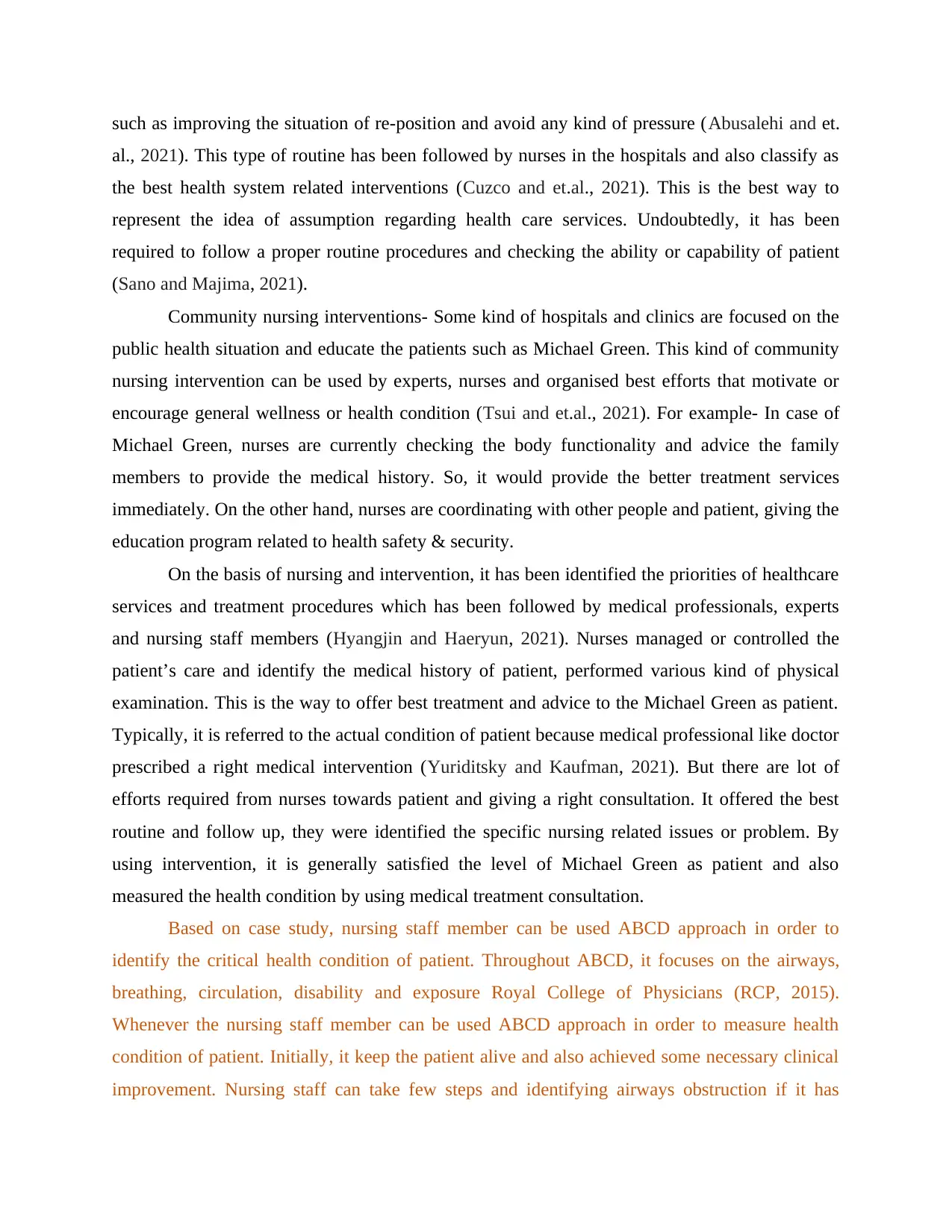
such as improving the situation of re-position and avoid any kind of pressure (Abusalehi and et.
al., 2021). This type of routine has been followed by nurses in the hospitals and also classify as
the best health system related interventions (Cuzco and et.al., 2021). This is the best way to
represent the idea of assumption regarding health care services. Undoubtedly, it has been
required to follow a proper routine procedures and checking the ability or capability of patient
(Sano and Majima, 2021).
Community nursing interventions- Some kind of hospitals and clinics are focused on the
public health situation and educate the patients such as Michael Green. This kind of community
nursing intervention can be used by experts, nurses and organised best efforts that motivate or
encourage general wellness or health condition (Tsui and et.al., 2021). For example- In case of
Michael Green, nurses are currently checking the body functionality and advice the family
members to provide the medical history. So, it would provide the better treatment services
immediately. On the other hand, nurses are coordinating with other people and patient, giving the
education program related to health safety & security.
On the basis of nursing and intervention, it has been identified the priorities of healthcare
services and treatment procedures which has been followed by medical professionals, experts
and nursing staff members (Hyangjin and Haeryun, 2021). Nurses managed or controlled the
patient’s care and identify the medical history of patient, performed various kind of physical
examination. This is the way to offer best treatment and advice to the Michael Green as patient.
Typically, it is referred to the actual condition of patient because medical professional like doctor
prescribed a right medical intervention (Yuriditsky and Kaufman, 2021). But there are lot of
efforts required from nurses towards patient and giving a right consultation. It offered the best
routine and follow up, they were identified the specific nursing related issues or problem. By
using intervention, it is generally satisfied the level of Michael Green as patient and also
measured the health condition by using medical treatment consultation.
Based on case study, nursing staff member can be used ABCD approach in order to
identify the critical health condition of patient. Throughout ABCD, it focuses on the airways,
breathing, circulation, disability and exposure Royal College of Physicians (RCP, 2015).
Whenever the nursing staff member can be used ABCD approach in order to measure health
condition of patient. Initially, it keep the patient alive and also achieved some necessary clinical
improvement. Nursing staff can take few steps and identifying airways obstruction if it has
al., 2021). This type of routine has been followed by nurses in the hospitals and also classify as
the best health system related interventions (Cuzco and et.al., 2021). This is the best way to
represent the idea of assumption regarding health care services. Undoubtedly, it has been
required to follow a proper routine procedures and checking the ability or capability of patient
(Sano and Majima, 2021).
Community nursing interventions- Some kind of hospitals and clinics are focused on the
public health situation and educate the patients such as Michael Green. This kind of community
nursing intervention can be used by experts, nurses and organised best efforts that motivate or
encourage general wellness or health condition (Tsui and et.al., 2021). For example- In case of
Michael Green, nurses are currently checking the body functionality and advice the family
members to provide the medical history. So, it would provide the better treatment services
immediately. On the other hand, nurses are coordinating with other people and patient, giving the
education program related to health safety & security.
On the basis of nursing and intervention, it has been identified the priorities of healthcare
services and treatment procedures which has been followed by medical professionals, experts
and nursing staff members (Hyangjin and Haeryun, 2021). Nurses managed or controlled the
patient’s care and identify the medical history of patient, performed various kind of physical
examination. This is the way to offer best treatment and advice to the Michael Green as patient.
Typically, it is referred to the actual condition of patient because medical professional like doctor
prescribed a right medical intervention (Yuriditsky and Kaufman, 2021). But there are lot of
efforts required from nurses towards patient and giving a right consultation. It offered the best
routine and follow up, they were identified the specific nursing related issues or problem. By
using intervention, it is generally satisfied the level of Michael Green as patient and also
measured the health condition by using medical treatment consultation.
Based on case study, nursing staff member can be used ABCD approach in order to
identify the critical health condition of patient. Throughout ABCD, it focuses on the airways,
breathing, circulation, disability and exposure Royal College of Physicians (RCP, 2015).
Whenever the nursing staff member can be used ABCD approach in order to measure health
condition of patient. Initially, it keep the patient alive and also achieved some necessary clinical
improvement. Nursing staff can take few steps and identifying airways obstruction if it has
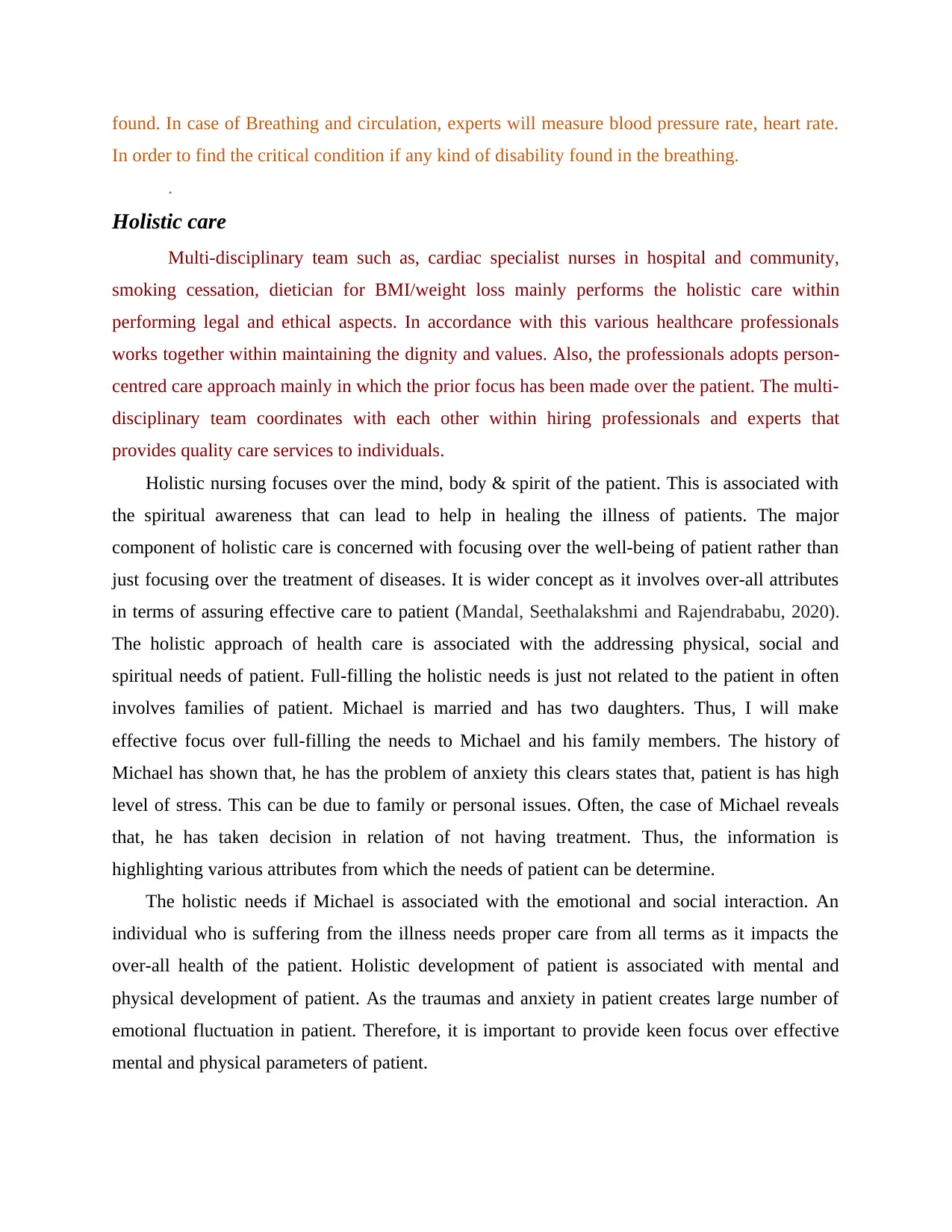
found. In case of Breathing and circulation, experts will measure blood pressure rate, heart rate.
In order to find the critical condition if any kind of disability found in the breathing.
.
Holistic care
Multi-disciplinary team such as, cardiac specialist nurses in hospital and community,
smoking cessation, dietician for BMI/weight loss mainly performs the holistic care within
performing legal and ethical aspects. In accordance with this various healthcare professionals
works together within maintaining the dignity and values. Also, the professionals adopts person-
centred care approach mainly in which the prior focus has been made over the patient. The multi-
disciplinary team coordinates with each other within hiring professionals and experts that
provides quality care services to individuals.
Holistic nursing focuses over the mind, body & spirit of the patient. This is associated with
the spiritual awareness that can lead to help in healing the illness of patients. The major
component of holistic care is concerned with focusing over the well-being of patient rather than
just focusing over the treatment of diseases. It is wider concept as it involves over-all attributes
in terms of assuring effective care to patient (Mandal, Seethalakshmi and Rajendrababu, 2020).
The holistic approach of health care is associated with the addressing physical, social and
spiritual needs of patient. Full-filling the holistic needs is just not related to the patient in often
involves families of patient. Michael is married and has two daughters. Thus, I will make
effective focus over full-filling the needs to Michael and his family members. The history of
Michael has shown that, he has the problem of anxiety this clears states that, patient is has high
level of stress. This can be due to family or personal issues. Often, the case of Michael reveals
that, he has taken decision in relation of not having treatment. Thus, the information is
highlighting various attributes from which the needs of patient can be determine.
The holistic needs if Michael is associated with the emotional and social interaction. An
individual who is suffering from the illness needs proper care from all terms as it impacts the
over-all health of the patient. Holistic development of patient is associated with mental and
physical development of patient. As the traumas and anxiety in patient creates large number of
emotional fluctuation in patient. Therefore, it is important to provide keen focus over effective
mental and physical parameters of patient.
In order to find the critical condition if any kind of disability found in the breathing.
.
Holistic care
Multi-disciplinary team such as, cardiac specialist nurses in hospital and community,
smoking cessation, dietician for BMI/weight loss mainly performs the holistic care within
performing legal and ethical aspects. In accordance with this various healthcare professionals
works together within maintaining the dignity and values. Also, the professionals adopts person-
centred care approach mainly in which the prior focus has been made over the patient. The multi-
disciplinary team coordinates with each other within hiring professionals and experts that
provides quality care services to individuals.
Holistic nursing focuses over the mind, body & spirit of the patient. This is associated with
the spiritual awareness that can lead to help in healing the illness of patients. The major
component of holistic care is concerned with focusing over the well-being of patient rather than
just focusing over the treatment of diseases. It is wider concept as it involves over-all attributes
in terms of assuring effective care to patient (Mandal, Seethalakshmi and Rajendrababu, 2020).
The holistic approach of health care is associated with the addressing physical, social and
spiritual needs of patient. Full-filling the holistic needs is just not related to the patient in often
involves families of patient. Michael is married and has two daughters. Thus, I will make
effective focus over full-filling the needs to Michael and his family members. The history of
Michael has shown that, he has the problem of anxiety this clears states that, patient is has high
level of stress. This can be due to family or personal issues. Often, the case of Michael reveals
that, he has taken decision in relation of not having treatment. Thus, the information is
highlighting various attributes from which the needs of patient can be determine.
The holistic needs if Michael is associated with the emotional and social interaction. An
individual who is suffering from the illness needs proper care from all terms as it impacts the
over-all health of the patient. Holistic development of patient is associated with mental and
physical development of patient. As the traumas and anxiety in patient creates large number of
emotional fluctuation in patient. Therefore, it is important to provide keen focus over effective
mental and physical parameters of patient.
Secure Best Marks with AI Grader
Need help grading? Try our AI Grader for instant feedback on your assignments.
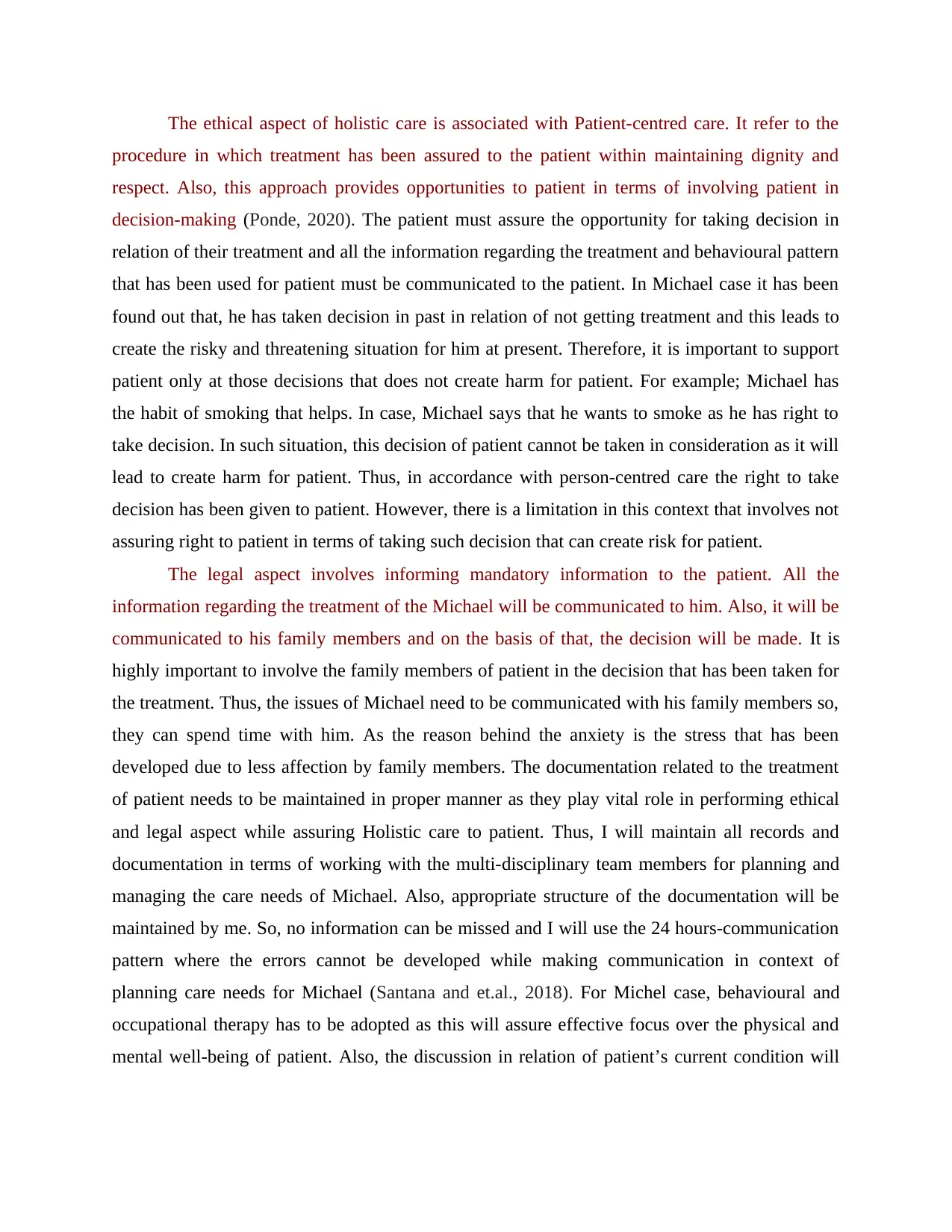
The ethical aspect of holistic care is associated with Patient-centred care. It refer to the
procedure in which treatment has been assured to the patient within maintaining dignity and
respect. Also, this approach provides opportunities to patient in terms of involving patient in
decision-making (Ponde, 2020). The patient must assure the opportunity for taking decision in
relation of their treatment and all the information regarding the treatment and behavioural pattern
that has been used for patient must be communicated to the patient. In Michael case it has been
found out that, he has taken decision in past in relation of not getting treatment and this leads to
create the risky and threatening situation for him at present. Therefore, it is important to support
patient only at those decisions that does not create harm for patient. For example; Michael has
the habit of smoking that helps. In case, Michael says that he wants to smoke as he has right to
take decision. In such situation, this decision of patient cannot be taken in consideration as it will
lead to create harm for patient. Thus, in accordance with person-centred care the right to take
decision has been given to patient. However, there is a limitation in this context that involves not
assuring right to patient in terms of taking such decision that can create risk for patient.
The legal aspect involves informing mandatory information to the patient. All the
information regarding the treatment of the Michael will be communicated to him. Also, it will be
communicated to his family members and on the basis of that, the decision will be made. It is
highly important to involve the family members of patient in the decision that has been taken for
the treatment. Thus, the issues of Michael need to be communicated with his family members so,
they can spend time with him. As the reason behind the anxiety is the stress that has been
developed due to less affection by family members. The documentation related to the treatment
of patient needs to be maintained in proper manner as they play vital role in performing ethical
and legal aspect while assuring Holistic care to patient. Thus, I will maintain all records and
documentation in terms of working with the multi-disciplinary team members for planning and
managing the care needs of Michael. Also, appropriate structure of the documentation will be
maintained by me. So, no information can be missed and I will use the 24 hours-communication
pattern where the errors cannot be developed while making communication in context of
planning care needs for Michael (Santana and et.al., 2018). For Michel case, behavioural and
occupational therapy has to be adopted as this will assure effective focus over the physical and
mental well-being of patient. Also, the discussion in relation of patient’s current condition will
procedure in which treatment has been assured to the patient within maintaining dignity and
respect. Also, this approach provides opportunities to patient in terms of involving patient in
decision-making (Ponde, 2020). The patient must assure the opportunity for taking decision in
relation of their treatment and all the information regarding the treatment and behavioural pattern
that has been used for patient must be communicated to the patient. In Michael case it has been
found out that, he has taken decision in past in relation of not getting treatment and this leads to
create the risky and threatening situation for him at present. Therefore, it is important to support
patient only at those decisions that does not create harm for patient. For example; Michael has
the habit of smoking that helps. In case, Michael says that he wants to smoke as he has right to
take decision. In such situation, this decision of patient cannot be taken in consideration as it will
lead to create harm for patient. Thus, in accordance with person-centred care the right to take
decision has been given to patient. However, there is a limitation in this context that involves not
assuring right to patient in terms of taking such decision that can create risk for patient.
The legal aspect involves informing mandatory information to the patient. All the
information regarding the treatment of the Michael will be communicated to him. Also, it will be
communicated to his family members and on the basis of that, the decision will be made. It is
highly important to involve the family members of patient in the decision that has been taken for
the treatment. Thus, the issues of Michael need to be communicated with his family members so,
they can spend time with him. As the reason behind the anxiety is the stress that has been
developed due to less affection by family members. The documentation related to the treatment
of patient needs to be maintained in proper manner as they play vital role in performing ethical
and legal aspect while assuring Holistic care to patient. Thus, I will maintain all records and
documentation in terms of working with the multi-disciplinary team members for planning and
managing the care needs of Michael. Also, appropriate structure of the documentation will be
maintained by me. So, no information can be missed and I will use the 24 hours-communication
pattern where the errors cannot be developed while making communication in context of
planning care needs for Michael (Santana and et.al., 2018). For Michel case, behavioural and
occupational therapy has to be adopted as this will assure effective focus over the physical and
mental well-being of patient. Also, the discussion in relation of patient’s current condition will
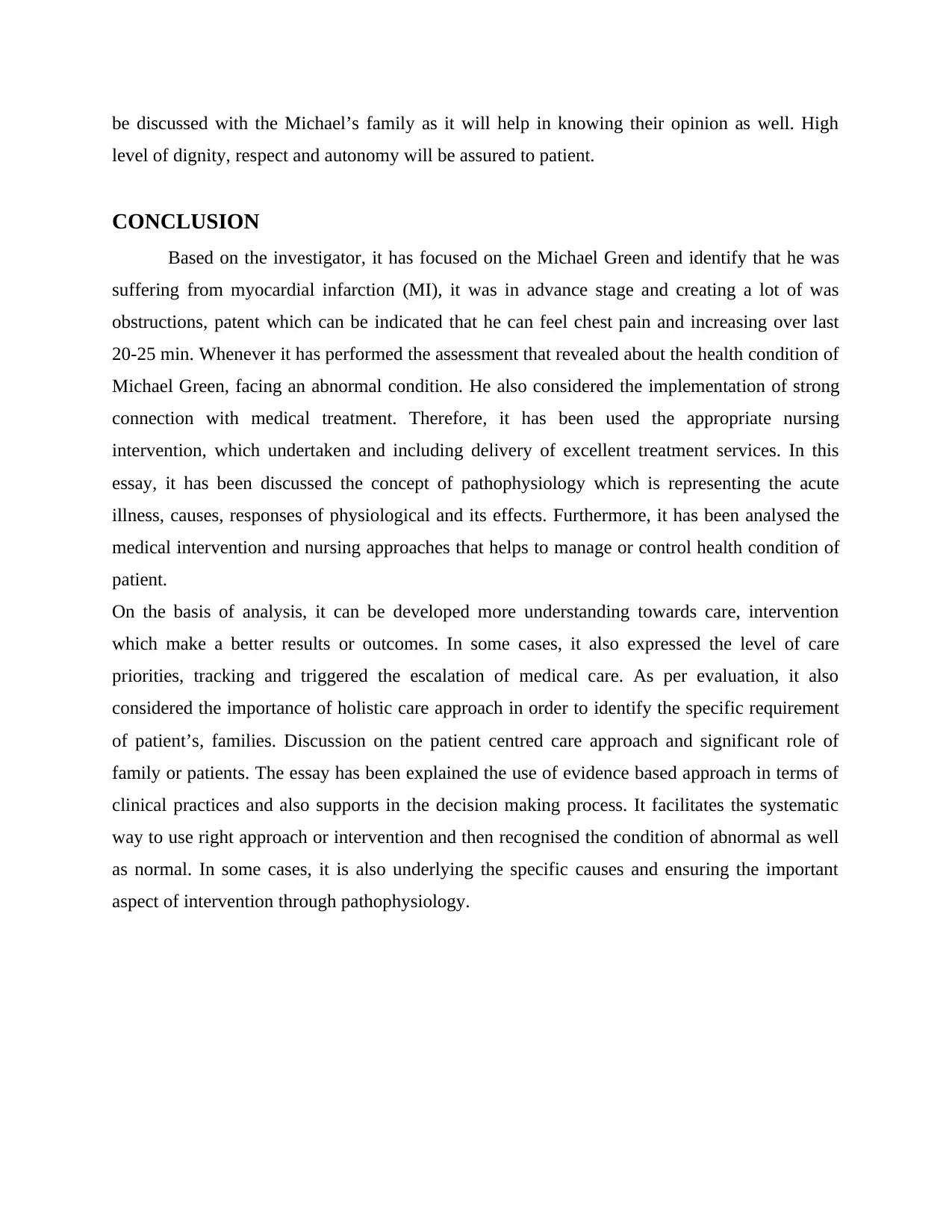
be discussed with the Michael’s family as it will help in knowing their opinion as well. High
level of dignity, respect and autonomy will be assured to patient.
CONCLUSION
Based on the investigator, it has focused on the Michael Green and identify that he was
suffering from myocardial infarction (MI), it was in advance stage and creating a lot of was
obstructions, patent which can be indicated that he can feel chest pain and increasing over last
20-25 min. Whenever it has performed the assessment that revealed about the health condition of
Michael Green, facing an abnormal condition. He also considered the implementation of strong
connection with medical treatment. Therefore, it has been used the appropriate nursing
intervention, which undertaken and including delivery of excellent treatment services. In this
essay, it has been discussed the concept of pathophysiology which is representing the acute
illness, causes, responses of physiological and its effects. Furthermore, it has been analysed the
medical intervention and nursing approaches that helps to manage or control health condition of
patient.
On the basis of analysis, it can be developed more understanding towards care, intervention
which make a better results or outcomes. In some cases, it also expressed the level of care
priorities, tracking and triggered the escalation of medical care. As per evaluation, it also
considered the importance of holistic care approach in order to identify the specific requirement
of patient’s, families. Discussion on the patient centred care approach and significant role of
family or patients. The essay has been explained the use of evidence based approach in terms of
clinical practices and also supports in the decision making process. It facilitates the systematic
way to use right approach or intervention and then recognised the condition of abnormal as well
as normal. In some cases, it is also underlying the specific causes and ensuring the important
aspect of intervention through pathophysiology.
level of dignity, respect and autonomy will be assured to patient.
CONCLUSION
Based on the investigator, it has focused on the Michael Green and identify that he was
suffering from myocardial infarction (MI), it was in advance stage and creating a lot of was
obstructions, patent which can be indicated that he can feel chest pain and increasing over last
20-25 min. Whenever it has performed the assessment that revealed about the health condition of
Michael Green, facing an abnormal condition. He also considered the implementation of strong
connection with medical treatment. Therefore, it has been used the appropriate nursing
intervention, which undertaken and including delivery of excellent treatment services. In this
essay, it has been discussed the concept of pathophysiology which is representing the acute
illness, causes, responses of physiological and its effects. Furthermore, it has been analysed the
medical intervention and nursing approaches that helps to manage or control health condition of
patient.
On the basis of analysis, it can be developed more understanding towards care, intervention
which make a better results or outcomes. In some cases, it also expressed the level of care
priorities, tracking and triggered the escalation of medical care. As per evaluation, it also
considered the importance of holistic care approach in order to identify the specific requirement
of patient’s, families. Discussion on the patient centred care approach and significant role of
family or patients. The essay has been explained the use of evidence based approach in terms of
clinical practices and also supports in the decision making process. It facilitates the systematic
way to use right approach or intervention and then recognised the condition of abnormal as well
as normal. In some cases, it is also underlying the specific causes and ensuring the important
aspect of intervention through pathophysiology.
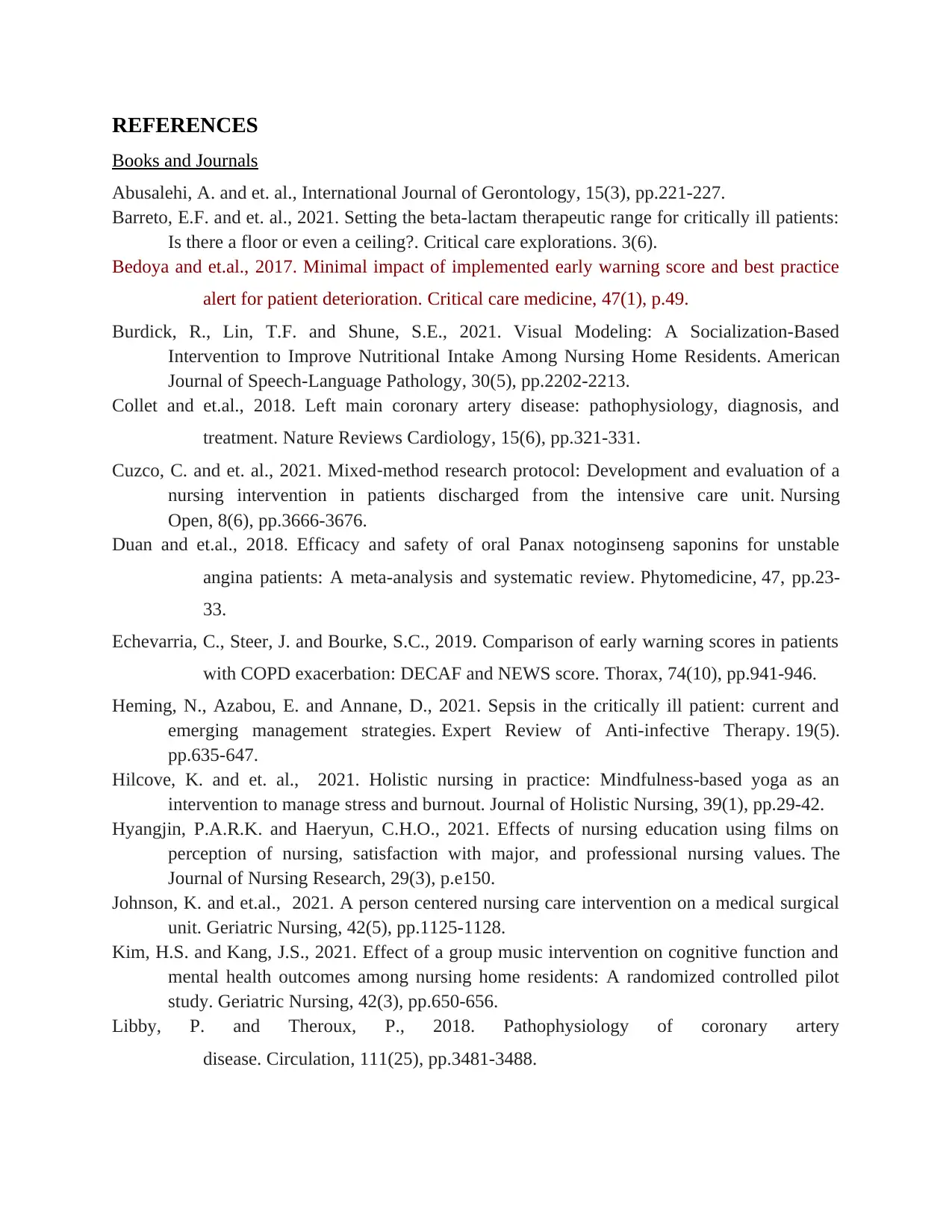
REFERENCES
Books and Journals
Abusalehi, A. and et. al., International Journal of Gerontology, 15(3), pp.221-227.
Barreto, E.F. and et. al., 2021. Setting the beta-lactam therapeutic range for critically ill patients:
Is there a floor or even a ceiling?. Critical care explorations. 3(6).
Bedoya and et.al., 2017. Minimal impact of implemented early warning score and best practice
alert for patient deterioration. Critical care medicine, 47(1), p.49.
Burdick, R., Lin, T.F. and Shune, S.E., 2021. Visual Modeling: A Socialization-Based
Intervention to Improve Nutritional Intake Among Nursing Home Residents. American
Journal of Speech-Language Pathology, 30(5), pp.2202-2213.
Collet and et.al., 2018. Left main coronary artery disease: pathophysiology, diagnosis, and
treatment. Nature Reviews Cardiology, 15(6), pp.321-331.
Cuzco, C. and et. al., 2021. Mixed‐method research protocol: Development and evaluation of a
nursing intervention in patients discharged from the intensive care unit. Nursing
Open, 8(6), pp.3666-3676.
Duan and et.al., 2018. Efficacy and safety of oral Panax notoginseng saponins for unstable
angina patients: A meta-analysis and systematic review. Phytomedicine, 47, pp.23-
33.
Echevarria, C., Steer, J. and Bourke, S.C., 2019. Comparison of early warning scores in patients
with COPD exacerbation: DECAF and NEWS score. Thorax, 74(10), pp.941-946.
Heming, N., Azabou, E. and Annane, D., 2021. Sepsis in the critically ill patient: current and
emerging management strategies. Expert Review of Anti-infective Therapy. 19(5).
pp.635-647.
Hilcove, K. and et. al., 2021. Holistic nursing in practice: Mindfulness-based yoga as an
intervention to manage stress and burnout. Journal of Holistic Nursing, 39(1), pp.29-42.
Hyangjin, P.A.R.K. and Haeryun, C.H.O., 2021. Effects of nursing education using films on
perception of nursing, satisfaction with major, and professional nursing values. The
Journal of Nursing Research, 29(3), p.e150.
Johnson, K. and et.al., 2021. A person centered nursing care intervention on a medical surgical
unit. Geriatric Nursing, 42(5), pp.1125-1128.
Kim, H.S. and Kang, J.S., 2021. Effect of a group music intervention on cognitive function and
mental health outcomes among nursing home residents: A randomized controlled pilot
study. Geriatric Nursing, 42(3), pp.650-656.
Libby, P. and Theroux, P., 2018. Pathophysiology of coronary artery
disease. Circulation, 111(25), pp.3481-3488.
Books and Journals
Abusalehi, A. and et. al., International Journal of Gerontology, 15(3), pp.221-227.
Barreto, E.F. and et. al., 2021. Setting the beta-lactam therapeutic range for critically ill patients:
Is there a floor or even a ceiling?. Critical care explorations. 3(6).
Bedoya and et.al., 2017. Minimal impact of implemented early warning score and best practice
alert for patient deterioration. Critical care medicine, 47(1), p.49.
Burdick, R., Lin, T.F. and Shune, S.E., 2021. Visual Modeling: A Socialization-Based
Intervention to Improve Nutritional Intake Among Nursing Home Residents. American
Journal of Speech-Language Pathology, 30(5), pp.2202-2213.
Collet and et.al., 2018. Left main coronary artery disease: pathophysiology, diagnosis, and
treatment. Nature Reviews Cardiology, 15(6), pp.321-331.
Cuzco, C. and et. al., 2021. Mixed‐method research protocol: Development and evaluation of a
nursing intervention in patients discharged from the intensive care unit. Nursing
Open, 8(6), pp.3666-3676.
Duan and et.al., 2018. Efficacy and safety of oral Panax notoginseng saponins for unstable
angina patients: A meta-analysis and systematic review. Phytomedicine, 47, pp.23-
33.
Echevarria, C., Steer, J. and Bourke, S.C., 2019. Comparison of early warning scores in patients
with COPD exacerbation: DECAF and NEWS score. Thorax, 74(10), pp.941-946.
Heming, N., Azabou, E. and Annane, D., 2021. Sepsis in the critically ill patient: current and
emerging management strategies. Expert Review of Anti-infective Therapy. 19(5).
pp.635-647.
Hilcove, K. and et. al., 2021. Holistic nursing in practice: Mindfulness-based yoga as an
intervention to manage stress and burnout. Journal of Holistic Nursing, 39(1), pp.29-42.
Hyangjin, P.A.R.K. and Haeryun, C.H.O., 2021. Effects of nursing education using films on
perception of nursing, satisfaction with major, and professional nursing values. The
Journal of Nursing Research, 29(3), p.e150.
Johnson, K. and et.al., 2021. A person centered nursing care intervention on a medical surgical
unit. Geriatric Nursing, 42(5), pp.1125-1128.
Kim, H.S. and Kang, J.S., 2021. Effect of a group music intervention on cognitive function and
mental health outcomes among nursing home residents: A randomized controlled pilot
study. Geriatric Nursing, 42(3), pp.650-656.
Libby, P. and Theroux, P., 2018. Pathophysiology of coronary artery
disease. Circulation, 111(25), pp.3481-3488.
Paraphrase This Document
Need a fresh take? Get an instant paraphrase of this document with our AI Paraphraser
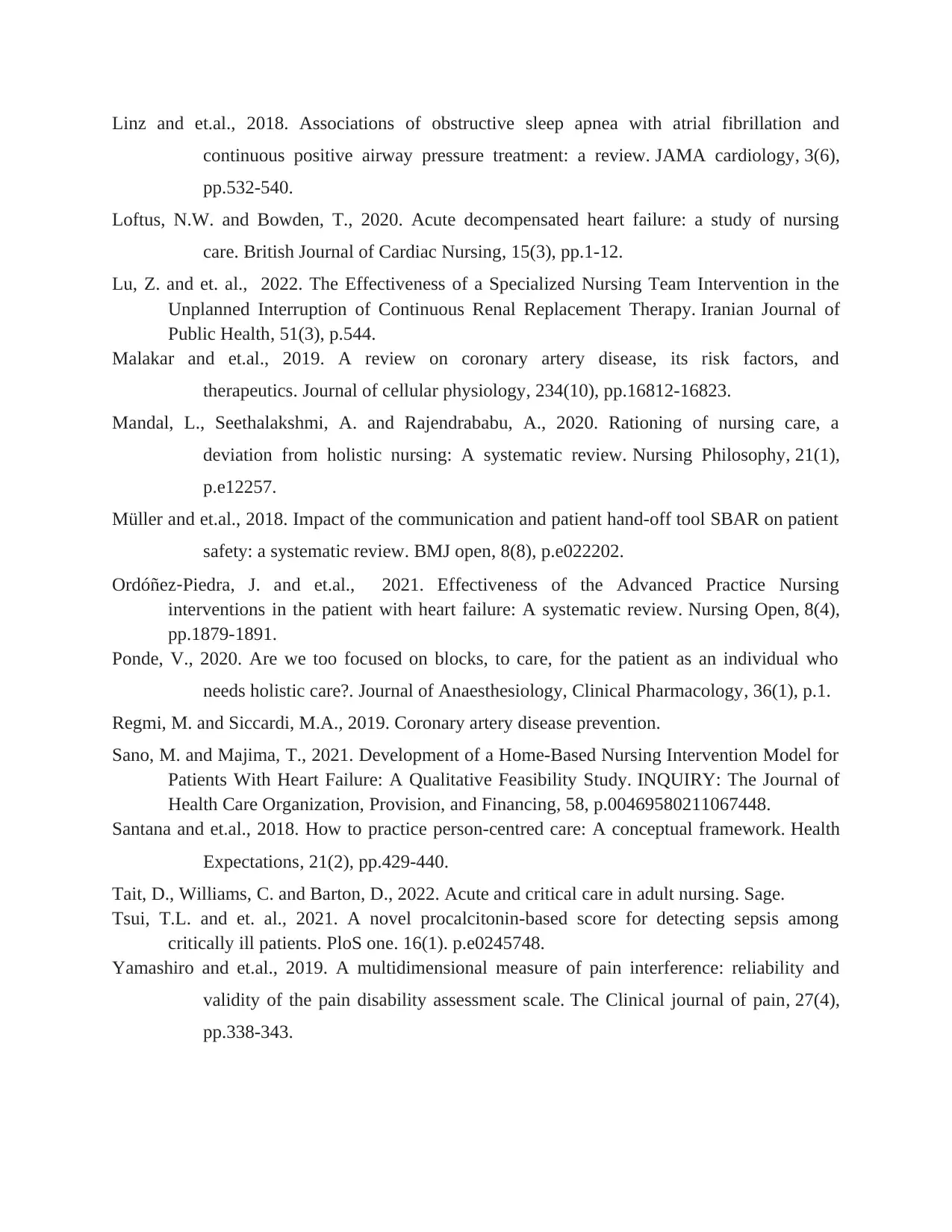
Linz and et.al., 2018. Associations of obstructive sleep apnea with atrial fibrillation and
continuous positive airway pressure treatment: a review. JAMA cardiology, 3(6),
pp.532-540.
Loftus, N.W. and Bowden, T., 2020. Acute decompensated heart failure: a study of nursing
care. British Journal of Cardiac Nursing, 15(3), pp.1-12.
Lu, Z. and et. al., 2022. The Effectiveness of a Specialized Nursing Team Intervention in the
Unplanned Interruption of Continuous Renal Replacement Therapy. Iranian Journal of
Public Health, 51(3), p.544.
Malakar and et.al., 2019. A review on coronary artery disease, its risk factors, and
therapeutics. Journal of cellular physiology, 234(10), pp.16812-16823.
Mandal, L., Seethalakshmi, A. and Rajendrababu, A., 2020. Rationing of nursing care, a
deviation from holistic nursing: A systematic review. Nursing Philosophy, 21(1),
p.e12257.
Müller and et.al., 2018. Impact of the communication and patient hand-off tool SBAR on patient
safety: a systematic review. BMJ open, 8(8), p.e022202.
Ordóñez‐Piedra, J. and et.al., 2021. Effectiveness of the Advanced Practice Nursing
interventions in the patient with heart failure: A systematic review. Nursing Open, 8(4),
pp.1879-1891.
Ponde, V., 2020. Are we too focused on blocks, to care, for the patient as an individual who
needs holistic care?. Journal of Anaesthesiology, Clinical Pharmacology, 36(1), p.1.
Regmi, M. and Siccardi, M.A., 2019. Coronary artery disease prevention.
Sano, M. and Majima, T., 2021. Development of a Home-Based Nursing Intervention Model for
Patients With Heart Failure: A Qualitative Feasibility Study. INQUIRY: The Journal of
Health Care Organization, Provision, and Financing, 58, p.00469580211067448.
Santana and et.al., 2018. How to practice person‐centred care: A conceptual framework. Health
Expectations, 21(2), pp.429-440.
Tait, D., Williams, C. and Barton, D., 2022. Acute and critical care in adult nursing. Sage.
Tsui, T.L. and et. al., 2021. A novel procalcitonin-based score for detecting sepsis among
critically ill patients. PloS one. 16(1). p.e0245748.
Yamashiro and et.al., 2019. A multidimensional measure of pain interference: reliability and
validity of the pain disability assessment scale. The Clinical journal of pain, 27(4),
pp.338-343.
continuous positive airway pressure treatment: a review. JAMA cardiology, 3(6),
pp.532-540.
Loftus, N.W. and Bowden, T., 2020. Acute decompensated heart failure: a study of nursing
care. British Journal of Cardiac Nursing, 15(3), pp.1-12.
Lu, Z. and et. al., 2022. The Effectiveness of a Specialized Nursing Team Intervention in the
Unplanned Interruption of Continuous Renal Replacement Therapy. Iranian Journal of
Public Health, 51(3), p.544.
Malakar and et.al., 2019. A review on coronary artery disease, its risk factors, and
therapeutics. Journal of cellular physiology, 234(10), pp.16812-16823.
Mandal, L., Seethalakshmi, A. and Rajendrababu, A., 2020. Rationing of nursing care, a
deviation from holistic nursing: A systematic review. Nursing Philosophy, 21(1),
p.e12257.
Müller and et.al., 2018. Impact of the communication and patient hand-off tool SBAR on patient
safety: a systematic review. BMJ open, 8(8), p.e022202.
Ordóñez‐Piedra, J. and et.al., 2021. Effectiveness of the Advanced Practice Nursing
interventions in the patient with heart failure: A systematic review. Nursing Open, 8(4),
pp.1879-1891.
Ponde, V., 2020. Are we too focused on blocks, to care, for the patient as an individual who
needs holistic care?. Journal of Anaesthesiology, Clinical Pharmacology, 36(1), p.1.
Regmi, M. and Siccardi, M.A., 2019. Coronary artery disease prevention.
Sano, M. and Majima, T., 2021. Development of a Home-Based Nursing Intervention Model for
Patients With Heart Failure: A Qualitative Feasibility Study. INQUIRY: The Journal of
Health Care Organization, Provision, and Financing, 58, p.00469580211067448.
Santana and et.al., 2018. How to practice person‐centred care: A conceptual framework. Health
Expectations, 21(2), pp.429-440.
Tait, D., Williams, C. and Barton, D., 2022. Acute and critical care in adult nursing. Sage.
Tsui, T.L. and et. al., 2021. A novel procalcitonin-based score for detecting sepsis among
critically ill patients. PloS one. 16(1). p.e0245748.
Yamashiro and et.al., 2019. A multidimensional measure of pain interference: reliability and
validity of the pain disability assessment scale. The Clinical journal of pain, 27(4),
pp.338-343.
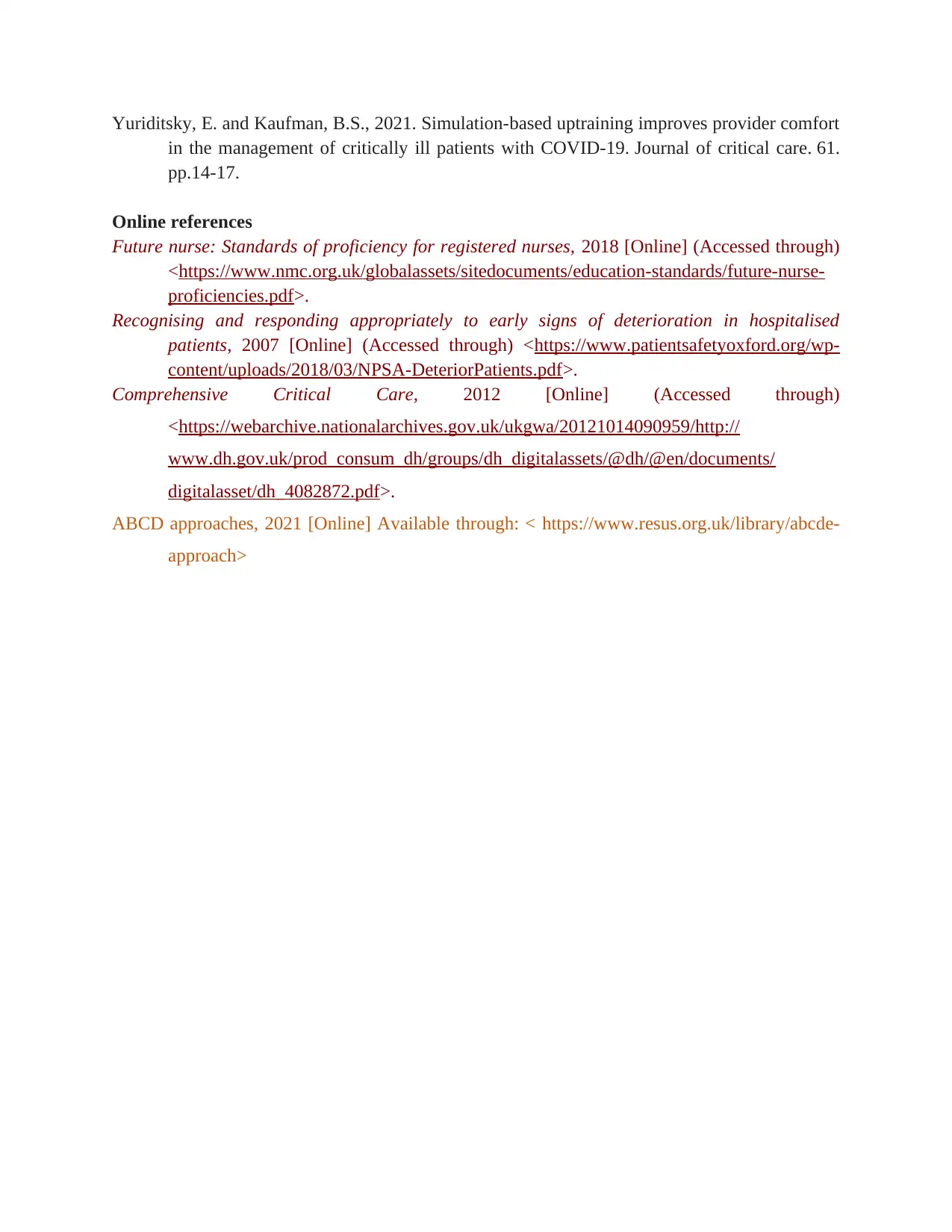
Yuriditsky, E. and Kaufman, B.S., 2021. Simulation-based uptraining improves provider comfort
in the management of critically ill patients with COVID-19. Journal of critical care. 61.
pp.14-17.
Online references
Future nurse: Standards of proficiency for registered nurses, 2018 [Online] (Accessed through)
<https://www.nmc.org.uk/globalassets/sitedocuments/education-standards/future-nurse-
proficiencies.pdf>.
Recognising and responding appropriately to early signs of deterioration in hospitalised
patients, 2007 [Online] (Accessed through) <https://www.patientsafetyoxford.org/wp-
content/uploads/2018/03/NPSA-DeteriorPatients.pdf>.
Comprehensive Critical Care, 2012 [Online] (Accessed through)
<https://webarchive.nationalarchives.gov.uk/ukgwa/20121014090959/http://
www.dh.gov.uk/prod_consum_dh/groups/dh_digitalassets/@dh/@en/documents/
digitalasset/dh_4082872.pdf>.
ABCD approaches, 2021 [Online] Available through: < https://www.resus.org.uk/library/abcde-
approach>
in the management of critically ill patients with COVID-19. Journal of critical care. 61.
pp.14-17.
Online references
Future nurse: Standards of proficiency for registered nurses, 2018 [Online] (Accessed through)
<https://www.nmc.org.uk/globalassets/sitedocuments/education-standards/future-nurse-
proficiencies.pdf>.
Recognising and responding appropriately to early signs of deterioration in hospitalised
patients, 2007 [Online] (Accessed through) <https://www.patientsafetyoxford.org/wp-
content/uploads/2018/03/NPSA-DeteriorPatients.pdf>.
Comprehensive Critical Care, 2012 [Online] (Accessed through)
<https://webarchive.nationalarchives.gov.uk/ukgwa/20121014090959/http://
www.dh.gov.uk/prod_consum_dh/groups/dh_digitalassets/@dh/@en/documents/
digitalasset/dh_4082872.pdf>.
ABCD approaches, 2021 [Online] Available through: < https://www.resus.org.uk/library/abcde-
approach>
1 out of 15
Related Documents
Your All-in-One AI-Powered Toolkit for Academic Success.
+13062052269
info@desklib.com
Available 24*7 on WhatsApp / Email
![[object Object]](/_next/static/media/star-bottom.7253800d.svg)
Unlock your academic potential
© 2024 | Zucol Services PVT LTD | All rights reserved.





